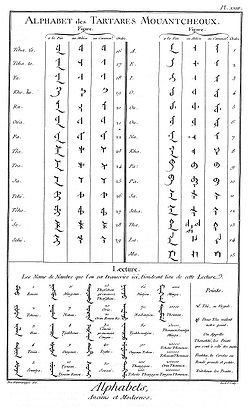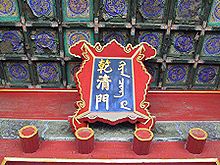- Manchu alphabet
-
Manchu script 
Type Alphabet Languages Manchu language
Xibe languageParent systems Proto-Sinaitic alphabetNote: This page may contain IPA phonetic symbols.  Chinese (left) and Manchu (right) writing in the Forbidden City
Chinese (left) and Manchu (right) writing in the Forbidden City
The Manchu alphabet was used for recording the now near-extinct Manchu language; a similar script is used today by the Xibe people, who speak a language descended from Manchu. It is written vertically from top to bottom, with columns proceeding from left to right.
Contents
History
According to the Veritable Records (Manchu:
 manju-i yargiyan kooli; Chinese: 滿洲實錄; pinyin: Mǎnzhōu Shílù), in 1599 the Manchu leader Nurhaci decided to convert the Mongolian alphabet to make it suitable for the Manchu people. He decried the fact that while illiterate Han Chinese and Mongolians could understand their respective languages when read aloud, that was not the case for the Manchus, whose documents were recorded by Mongolian scribes. Overriding the objections of two advisors named Erdeni and G'ag'ai, he is credited with adapting the Mongolian script to Manchu. The resulting script was known as tongki fuka akū hergen ("script without dots and circles").
manju-i yargiyan kooli; Chinese: 滿洲實錄; pinyin: Mǎnzhōu Shílù), in 1599 the Manchu leader Nurhaci decided to convert the Mongolian alphabet to make it suitable for the Manchu people. He decried the fact that while illiterate Han Chinese and Mongolians could understand their respective languages when read aloud, that was not the case for the Manchus, whose documents were recorded by Mongolian scribes. Overriding the objections of two advisors named Erdeni and G'ag'ai, he is credited with adapting the Mongolian script to Manchu. The resulting script was known as tongki fuka akū hergen ("script without dots and circles").In 1632, Dahai added diacritical marks to clear up a lot of the ambiguity present in the original Mongolian script; for instance, a leading k, g, and h are distinguished by the placement of no diacritical mark, a dot, and a circle respectively. This revision created the Standard script, known as tongki fuka sindaha hergen ("script with dots and circles"). As a result, the Manchu alphabet contains little ambiguity. Recently discovered manuscripts from the 1620s make clear, however, that the addition of dots and circles to Manchu script began before their supposed introduction by Dahai.
Dahai also added ten graphemes (tulergi hergen: "foreign (outer) letters"), to allow Manchu to be used to write Chinese and Sanskrit loanwords. Previously, these words contained sounds that did not have corresponding letters in Manchu. [1] Sounds that were transliterated included the aspirated sounds kh, gh, hh; ts' (Chinese pinyin: c); ts (Chinese pinyin: ci); sy (Chinese pinyin: si); dz (Chinese pinyin: z); c'y (Chinese pinyin: chi); jy (Chinese pinyin: zhi); and ž (Chinese pinyin: r). [2]
By the middle of the nineteenth century, there were three styles of writing Manchu in use: standard script (ginggulere hergen), semicursive script (gidara hergen), and cursive script (lasihire hergen). Semicursive script had less spacing between the letters, and cursive script had rounded tails. [3]
Alphabet
Characters Transliteration Unicode Notes isolated initial medial final Vowels [4] ᠠ ᠠ᠊ ᠊ᠠ᠊ ᠊ᠠ a 1820 ᠊ᠠ᠋ ᡝ ᡝ᠊ ᠊ᡝ᠊ ᠊ᡝ e 185D Second final form is used after [k] [g] [x] kh gh hh [5] (  )
)ᡳ ᡳ᠊ ᠊ᡳ᠊ ᠊ᡳ i 1873 ᠊ᡳ᠌᠊ ᠊ᡳ᠍᠊ ᠊ᡳ᠋ ᠊ᡳ᠌ ᠣ ᠣ᠊ ᠊ᠣ᠊ ᠊ᠣ o 1823 ᠊ᠣ᠋ ᡠ ᡠ᠊ ᠊ᡠ᠊ ᠊ᡠ u 1860 ?? ᡡ ᡡ᠊ ᠊ᡡ᠊ ᠊ᡡ ū/uu/v ᡟ (  )
)᠊ᡟ᠊ ᠊ᡟ y/y/i' 185F Consonants [6] 

 ???
???n 1828 First medial form is used before vowels; second is used before consonants 

ng 1829 First medial form is used before i o u ū; second is used before e i 


k [q] 1874 First medial form is used before a o ū; second is used before consonants 



k [k] 1874 
g [ɢ] 1864 g [g] 1864 h [χ] 1865 h [x] 1865 


b 182A p 1866 


s 1867 š 1867 


t 1868 First initial and medial forms are used before a o i;
second initial and medial forms are used before e u ū;
third medial form is used before consonantsd 1869 First initial and medial forms are used before a o i;
second initial and medial forms are used before e u ū



l 182F 


m 182E 

c/ch/c 1834 

j/zh/j 1835 

r 1875 f 1875 First initial and medial forms are used before a e;
second initial and medial forms are used before i o u ū




— v (w) 1838 Punctuation
The Manchu alphabet has two kinds of punctuation: two dots, analogous to a period; and one dot, analogous to a comma. However, with the exception of lists of nouns being reliably punctuated by single dots, punctuation in Manchu is inconsistent, and therefore not of much use as an aid to readability. [7]
The equivalent of the question mark in Manchu script consists of some special particles, written at the end of the question. [8]
Jurchen script
The Jurchens were the ancestors of the Manchus, and their language, the Jurchen language is ancestral to the Manchu language, and their script was derived from the Khitan script, which was in turn derived from Chinese.
Examples
Wikipedia written in Manchu

See also
- Transliterations of Manchu
References
- ^ Gorelova, L: "Manchu Grammar", page 50. Brill, 2002.
- ^ Gorelova, L: "Manchu Grammar", pages 71-72. Brill, 2002.
- ^ Gorelova, L: "Manchu Grammar", page 72. Brill, 2002.
- ^ Gorelova, L: "Manchu Grammar", page 59. Brill, 2002.
- ^ Gorelova, L: "Manchu Grammar", page 53. Brill, 2002.
- ^ Gorelova, L: "Manchu Grammar", page 70. Brill, 2002.
- ^ Li, G: "Manchu: A Textbook for Reading Documents", page 21. University of Hawai'i Press, 2000.
- ^ Gorelova, L: "Manchu Grammar", page 74. Brill, 2002.
External links
- Unicode Manchu/Sibe/Daur Fonts and Keyboards
- Manchu alphabet
- Manchu script generator (Romanization → Manchu script (also for download))
- ManchuFont — an OpenType font for Manchu writing
- Jurchen Script
Categories:- Alphabetic writing systems
- Manchu language
Wikimedia Foundation. 2010.

